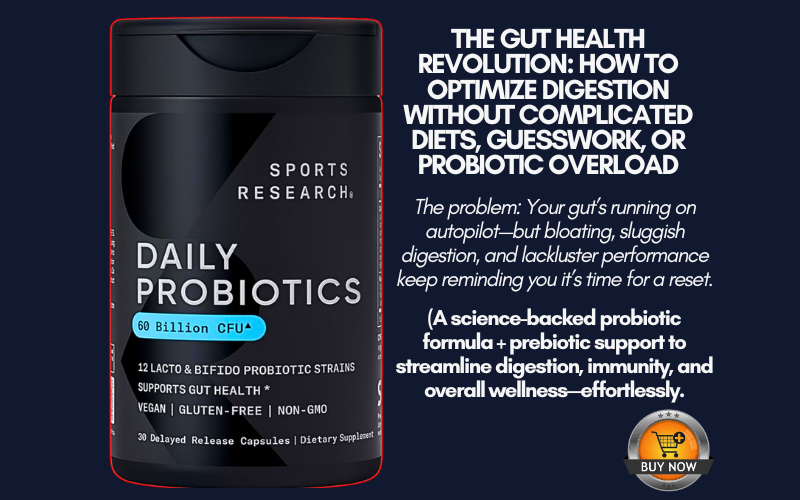Probiotics vs. Prebiotics: What’s the Difference?
Let’s cut the chase: probiotics are live bacteria that colonize your gut like microscopic gym bros, while prebiotics are the plant fibers that feed them. Both are non-negotiables for lifters chasing aesthetics, strength, and a gut that doesn’t sabotage gains. But here’s the key difference: probiotics are the workers; prebiotics feed the workers. Miss one, and your gut’s construction site turns into a demolition zone.
The Ironclad Science of Gut Warfare
Your gut isn’t just a tube—it’s a battlefield. Trillions of microbes duke it out daily, and the winner decides whether you’re bloated, inflamed, or primed to deadlift a truck.
| Category | What They Are (The Nitty-Gritty) | What They Do (The Deeper Impact) | Where to Find Them (Beyond the Basics) | Think Of It As (The Extended Analogy) |
|---|---|---|---|---|
| Probiotics | Specific strains of live microorganisms, often bacteria but can also include yeasts. These strains have demonstrated health benefits when consumed in adequate amounts, often targeting specific areas of the digestive tract. The viability and strain specificity are crucial for their effectiveness. | Beyond just crowding out bad bacteria, they can influence the gut-brain axis, impact the production of short-chain fatty acids (SCFAs) like butyrate (important for gut lining health), help modulate the immune system locally in the gut, and even play a role in the synthesis of certain vitamins. Their effects are strain-dependent. | Look beyond the obvious: Fermented vegetables like natto (fermented soybeans). Miso (fermented soybean paste). Tempeh (another fermented soybean product). Certain aged cheeses (though the live cultures may vary). Probiotic-fortified foods and supplements (pay close attention to the specific strains listed). | Like introducing a skilled team of specialized workers into a factory (your gut). Each worker (specific strain) has a unique role in optimizing production, fixing malfunctions, and even improving the overall efficiency of the system. Their success depends on their specific skills and their ability to integrate into the existing environment. |
| Prebiotics | Non-digestible compounds, primarily fibers, that selectively stimulate the growth and/or activity of beneficial microorganisms already residing in your colon. They essentially bypass digestion in the upper GI tract and become a food source for the good bacteria in the lower gut. | By selectively feeding beneficial bacteria, prebiotics can lead to an increase in their populations and the production of beneficial metabolites (like SCFAs). This can improve gut barrier function, enhance mineral absorption (like calcium and magnesium), influence satiety signals, and contribute to a more balanced and resilient microbiome. | Explore these sources: Jerusalem artichokes. Dandelion greens. Leeks. Onion family (shallots, scallions). Whole grains like barley and oats (resistant starch). Legumes (beans, lentils). Certain fruits like apples (pectin). | Like providing essential resources and creating the ideal conditions for the existing workforce in the factory (your gut) to thrive and expand. By supplying the right fuel, you encourage the growth of the most productive teams, leading to increased output and a more robust and efficient operation. |

The Synergy: Why You Need Both
“Probiotics without prebiotics is like buying a Lamborghini and forgetting the gas.” — Charles Damiano, B.S. Clinical Nutrition
Your gut’s ecosystem needs balance. Probiotics introduce reinforcements; prebiotics keep them fed. Together, they:
- Boost nutrient absorption (more gains per bite).
- Reduce inflammation (so you recover like Wolverine).
- Prevent “protein farts” (aesthetics include not clearing rooms).
Who This Is For (And Who It’s Not)
FOR: Lifters, athletes, desk jockeys wanting to:
- Lift heavier without gut rot
- Carve a six-pack that isn’t hidden under bloat
- Outlast younger guys in pickup basketball
NOT FOR:
- Those with severe IBS/SIBO (talk to a doc first)
- Anyone allergic to fermenteds (sorry, sauerkraut haters)
The Lifter’s Gut Protocol
- Eat fermented foods daily (a forkful of kimchi post-workout).
- Crush prebiotic fibers (add raw garlic to your steak).
- Rotate strains (don’t marry one yogurt brand).
“Your gut is a petri dish. Treat it like one.” — Eugene Thong, CSCS

Your Gut’s Dirty Secrets: 6 Burning Questions Lifters Are Too Embarrassed to Ask
You’ve got the basics down—probiotics are the bouncers, prebiotics are the buffet. But what about the gritty details gym bros whisper between sets? The questions that make even seasoned lifters side-eye their protein shakers? Let’s drag those skeletons out of the supplement cabinet…
A: Depends. A dialed-in gut can turn “emergency bathroom sprint” into “clockwork,” but overdoing probiotics might turn you into a porcelain ambassador. Start slow. Rotate strains. Your colon isn’t a CrossFit WOD.
A: Nice try. Prebiotics feed good bacteria, but they don’t magically scrub pizza grease from your arteries. They can, however, help mitigate bloat and inflammation—so you’ll look less like a microwaved burrito post-cheat.
A: Heavy pulls spike cortisol, which can gut-punch your microbiome. Pair post-deadlift meals with prebiotic fibers (think sweet potatoes) to soothe the warzone. Your gut isn’t weak—it’s just outlifted.
A: Not all. But most are as useless as a treadmill in a powerlifting gym. Seek third-party tested brands with 10+ strains. Better yet: eat fermented foods. Your gut prefers kimchi over lab-grown dust in a capsule.
A: Indirectly, yes. Reduced inflammation = sharper muscle definition. Plus, efficient nutrient absorption means more fuel for growth. Your guns won’t magically inflate, but they’ll pop like they’re airbrushed.
A: Cool—keep bonding with your bloated, gassy alter ego. But remember: your gut controls 70% of your immune system. Ignore it, and you’ll be the guy sniffling through gains season. Your call, champ.

YOUR NEXT STEPS:
